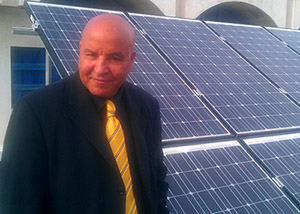Actually PV-technology is the third most important renewable energy source in terms of globally installed capacity after hydro and wind power. In 2012, the European Photovoltaic Industry Association (EPIA) reported the addition of 31.1 GW of new PV capacity, up from 30.4 GW in 2011, which brings the cummulative global solar PV installed capacity above 100 GW. For reference purposes, one power plant reactor produces about 1.3 GW of electricity per year (1 GW = 1 billion watts). Overall, the global deployment of BIPV is small in comparison with of globally installed PV. However, according to a new report from NanoMarkets, BIPV systems worldwide is expected to grow from over 400 MW in 2012 to 2,250 MW in 2017, and the market for building-integrated photovoltaic technology is expected to boom in the next few years, moving from $606 million this year to $2.4 billion. BIPVs are photovoltaic materials that replace conventional building materials in parts of the building envelopes, such as the roof covering or facades and serves as a building envelope material and power generator simultaneously. BIPV systems may represent a powerful and versatile tool for achieving the ever increasing demand for zero energy and zero emission buildings of the near future. In this respect BIPVs offer an aesthetical, economical and technical solution to integrate solar cells harvesting solar radiation to produce electricity within the climate envelopes of buildings. To achieve such goal we believe that architects should work together with R&D scientists to design and successfully integrate solar panels into the building as functional/constructive component replacing the traditional building element. The PV system must of course meet the criteria of efficiency in energy production, particularly with regard to positioning and orientation of the modules and the absence of shading. In this talk we, summarizes the current state-of-the-art of PV technology with particular interest to thin films and BIPV. Secondly, we discuss a possible future research opportunities and pathways for the BIPVs to be integrated in both new and existing buildings in Morocco. The following thin films technologies can be developed with reduced production costs and improved building integration. – Wafer silicon technology – Flexible lightweight inorganic thin film solar cells in roll-to-Roll – See-through thin-film PV products, semi-transparent characteristic that provide wonderful visual comfort. – New concept that use less material (Extremely Thin Absorber or ETA) – Dye sensitized (DSSC) and Perovskite solar cells – Organic polymer technology
*Research director Institute Heterogeneous Material Systems at HZB
*Serving as president of the scientific council of IRESEN
*Member of EU Photovoltaic Technology Platform Expert Pool
Biography of Prof. Ahmed Ennaoui
Prof. Ahmed Ennaoui is born and brought up in Morocco. Actually he is research director at Helmholtz-Zentrum Berlin für Materialien und Energie (HZB)/Germany, (the former Hahn-Meitner-Institute, HMI). His research interests are advanced materials, nanosynthesis, photoelectrochemistry, solid-state devices. He is working in scaling up new thin film technology process to reduce the Fab-to-Lab gap. Recently he is exploring Cu-chalcopyrite and Cu-Kesterite Cu2ZnSn(S,Se)4 nanoparticles, NPs ink for printing technology, novel fabrication techniques, non-vacuum techniques and novel device concepts for next generation solar cell. He is author and co-author of more than 200 scientific papers and 3 patents. He published two special issues in the journal Solar Energy Materials and Solar Cells on innovative materials for solar energy conversion. With h-index 33, Ahmed Ennaoui belongs to the most cited scientist in the field of materials for solar energy conversion and PV-technology. He is involved in the coordination of several grant projects financed by the European commission, the Federal Ministry of Education and Research (Germany). He is awarded for several European projects (Joule II, CIS-Line, NEBULUS, ATHLET, CHEETAH) and worked on several feasibility studies finaced by the industry (Siemens, Shell solar, Avancis, Bosch, Atotech, SOLIBRO). Since 2009 he is working with Prof. Matsumura in the Research Center for Solar Energy Chemistry at Osaka University, supervising several PhD and MS students. He taught several courses and seminars at Osaka University on Research Opportunities in Cu-chalcogenide Materials and electroplating of binary and ternary compounds for PV applications. Meanwhile he is supervising student at HZB and involved in Tutorial works at FU “Freie Universität” Berlin on the Renewable Energies Seminar “Lehrseminar Erneuerbare Energien”. He is serving as president of Scientific Advisory Board for the Moroccan “Institut de Recherche en Energie Solaire et Energies Nouvelles, IRESEN” and in the scientific committee for AFRICAPVSEC conference, for the Editorial Board of Solar Energy Materials and Solar Cells, International Journal of Photoenergy, Journal of New Technology and Materials, Journal of Optics and Photonics. He served as referee for Scientific, evaluation and Expertise of Research proposal for Technology Foundation STW ( Dutch funding agency for academic research in the field of applied sciences) and Scientific, evaluation and Expertise of the program “sinergia” lunched by “Schweizerische Nationalfonds”(SNF). He is Member of EU Photovoltaic Technology Platform Expert Pool. He is member of American Chemical Society and Royal Society of Chemistry. He his awarded as invited lecture for plenary session, 2014 of the academy of sciences Hassan II. He is serving as Co-chair for World Renewable Energy Congress /Photovoltaic, E-MRS-Spring meeting / Thin Film Chalcogenide and co-chair for AfricaPVSEC conference.
